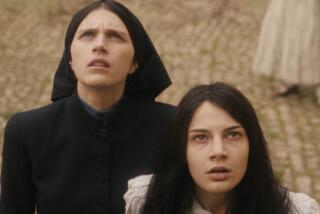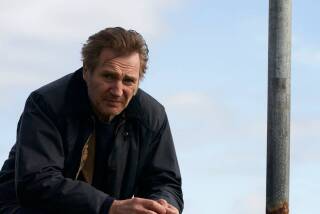Embracing a land’s heart of stone
Lisdoonvarna, Ireland
WE walked through fields of flowers — masses of wild geraniums, goldenrod and daisies — to begin our Abbey Hill climb. Once we had cleared the meadow, our guide, Shane Connolly, stopped and assembled our group for a brief orientation.
Connolly, a wiry young County Clare farmer, has degrees in archeology and Irish history. When’s he’s not tending his farm and cattle, he guides hikers through the strange and interesting limestone landscape of the Burren, which covers more than 100 square miles along the Atlantic Coast in northern County Clare.
My husband, Tom, and I visited the region last August; I was soaking up local color for a mystery novel I’m writing. We had driven through the Burren on other visits to Ireland — it’s on the way to the Cliffs of Moher, the most famous tourist spot in the area — and had noticed the odd beauty of the land. We didn’t know that the rockscape broods over a past that reaches into prehistory and even legend.
But Connolly had studied the past and the present of the Burren as well as its folklore. I knew we were in good hands when he assembled our group of nine hikers on a promontory. He pointed his walking stick in various directions, locating us in place and time.
“You are in the kingdom of Thomond, the ancient barony of the Burren, the province of Munster and the county of Clare. Fifty-three degrees latitude, 9 degrees west of Greenwich, England.” He pointed to land that stretched into the distance behind the nearer hills and mountains. “The great central plain of Ireland and, farther east, Stoke-on-Trent in England. Westward, the open Atlantic, then Hudson Bay in Canada.”
Across Galway Bay we could see the mountains of Connemara — and in the near distance was a Martello tower guarding the entrance to Galway Bay. Martello towers, squat fortifications built by the English during the Napoleonic Wars, dot the coast of Ireland.
Connolly told us that “Burren” derives from the Irish word for “stony place.” It is an apt name. Shiny, silver limestone extends in all directions, creating high hills, cliffs and terraces. At the edge of Clare, the Burren dips back into the sea, its natural home, and resurfaces to create the Aran Islands, which are west of Clare.
Limestone makes the land do strange things. Because of the stone’s porous quality, water disappears into underground rivers and floods a network of subterranean caves. Occasional heavy rains fill up the underground system and cause turloughs — temporary lakes — to form.
Wildflowers are the second miracle of the Burren. Connolly knew them all and delivered a mix of botany and folklore in the most offhanded way. There were wild thyme, St. John’s wort, harebell and eyebright. Hidden here and there we found tiny orchids. One was called “O’Kelly’s orchid,” named for a botanist from Ballyvaughan, the nearest town and Connolly’s home.
We even saw mountain aven, which usually grows only in alpine regions. Like other alpine plants found here, Connolly said, it was brought to this area over land bridges that disappeared when the last glacial period ended. The odd mix of flora interests botanists and flower enthusiasts like me. A small limestone terrace can host plants from alpine regions along with Mediterranean species. As expected, alkaline-loving plants flourish in the Burren, but so do acid-loving plants, which find shelter in small pockets of peat that the wind supplies. The flowers fill tiny cracks and large fissures in the limestone.
From a distance the hills may look barren, but they are not. As a matter of fact, the Cistercian monks called Corcomroe Abbey, their church here, “St. Mary of the Fertile Rocks.” When we turned away from the sea, we could see the abbey’s ruins in the valley below.
A day of hiking, a night at pubs
On our descent from Abbey Hill, Connolly showed us St. Patrick’s Well, which he said was holy. He told us that holy wells have Christian associations, but most are thought to have been sacred for pre-Christian people as well. He pointed out engravings on the wall of the well: a shamrock, cross and harp were carved into the rough stone, and an effigy of a saint, probably taken from an early Celtic church, had been affixed to the limestone. Connolly said, “You take something from the well and you leave something behind.” He reached below eye level and came up holding a millennium cup, a St. Patrick prayer card and a medal of St. Teresa. He replaced the well offerings before leading us down the hill.We ended our five-hour hike on a famine road. A humble stone-and-gravel byway, the road was a government project that provided work — and relief — to those suffering in the Great Famine that began in 1846. Irish poet Eavan Boland, a Dubliner born in 1944, wrote of a famine road: “Where they died, there the road ended and ends still.” Indeed, the road did seem to come out of nowhere and end just as abruptly.
A day of hiking justified an evening in the pubs. We began at our home base, Lisdoonvarna, a town famous not only for Burren touring but also for its mineral springs. The town was large enough to make it difficult for us to find our hotel on arrival and small enough for us to wonder later how we could ever have been lost. Irish tourists have visited Lisdoonvarna since the 19th century, when they came here seeking the healing waters of the baths.
It is famous for another reason too. We were told that, after harvest season, the men came seeking wives because Lisdoonvarna is known as the matchmaking center of Ireland.
Sensible shoes, layered clothing
Our pub crawl started at the Rathbawn, a small hotel and pub on Main Street. A lively musical group called Ceolan played and sang standards such as “Danny Boy,” “The Foggy Dew” and “The Boys Won’t Leave the Girls Alone.” We ended in Gus O’Connor’s pub in nearby Doolin. Both the town and the pub are famous for Irish music. Inside O’Connor’s, patrons perched on low stools working their way through hefty platters of salmon, beef, potatoes and several vegetables. Dutch backpackers, Irish couples, a few Americans — all tapped their feet and bounced their heads in rhythm to the music.Two days later we met Connolly again, this time for a morning hike on Black Head, a steep limestone mountain with an Iron Age fort and other prehistoric remains. There were five of us on the tour — a Clare woman, an English couple, my husband and I. Connolly said he had stopped at a hotel to pick up two others, both women, but he had to “knock them off the tour” because they didn’t have proper shoes. I asked what kind of shoes they were wearing, and he answered. “Now, I’ll tell you. The one had these little red shoes you might see a lady lift up her evening gown to show you.”
Of course, sensible shoes, rain gear and layered clothing were all fundamentals for walking in the Burren. The limestone was slippery and uneven. Even on bright, clear days, rain seemed to come from nowhere, pour down for a few minutes and then disappear. It could feel warm at the base of a hill and become windy and chilly as we climbed. At times we followed a green trail, a cattle track known as the Burren Way; other times we climbed through limestone terraces and navigated the fissures where the limestone had split.
We had a great view even before we started climbing Black Head, which rises abruptly from the coastline. We could see Inisheer, the smallest of the Aran Islands, just a few miles out to sea. Passing wildflowers in small depressions in the limestone, we began our ascent. Connolly had supplied us with hazel walking sticks, and we wielded them as we pushed ourselves up the steep hill.
Prehistoric sites were the focus of our walk. On a high ridge we stopped at an Iron Age ring fort. A large area, 25 feet or so in diameter, was encircled by sandwich stacks of limestone. Connolly said that the Firborg, the early Celts, had built the fort, and it once held livestock and people. Many prehistoric relics, including wedge tombs, dolmens, forts, cairns and cooking sites, can be found on the Burren. Some of the wedge tombs were used for human habitation as late as the 18th century. Connolly said the Black Head fort was left alone because the “little people” lived there. Outside its stone walls, we saw feral goats nibbling on a thatch of wildflowers.
On a lower flank of Black Head, Connolly pointed out a prehistoric cooking site. There are hundreds of them on the Burren; they can be detected by a horseshoe-shaped ring of stones that surrounds a spring. The Black Head pool ran aboveground for 40 feet. Bronze Age people took advantage of the surface water by heating stones and then throwing them into the pool to create a boiling cauldron.
Connolly said, “You can see that the spring is still doing some good,” pointing to a pipe nearly hidden by the rocks. “That’s Joseph Casey’s pipe there, running water to feed his cattle.” Continuing a custom from prehistoric times, Burren livestock farmers let their cows graze in the valley during the summer and then bring them up into the highlands of the Burren for the winter.
An English hiker questioned Connolly about this, though, mentioning a famous quote found in all Burren guidebooks. Gen. Edmund Ludlow, a follower of Oliver Cromwell, wrote in his memoir, “We entered into the Barony of Burren, of which it is said, that it is a country where there is not water enough to drown a man, wood enough to hang one, nor earth enough to bury him.”
Connolly answered, “Ah, that is often quoted and, more often, misquoted. Rarely does anyone include the rest of the line, which states, ‘yet their cattle are very fat.’ ”
With the cattle question set to rest, we continued our walk. I thought of all the history and prehistory we had learned during our short visit to the Burren.
We had stood on an ancient seabed and looked at alpine flowers. We had seen an Iron Age fort and a prehistoric cooking site. We had looked over the ruined abbey and heard about the “little people.” It was a reminder that legend and history share a stony silence in the Burren.
More to Read
Sign up for The Wild
We’ll help you find the best places to hike, bike and run, as well as the perfect silent spots for meditation and yoga.
You may occasionally receive promotional content from the Los Angeles Times.






